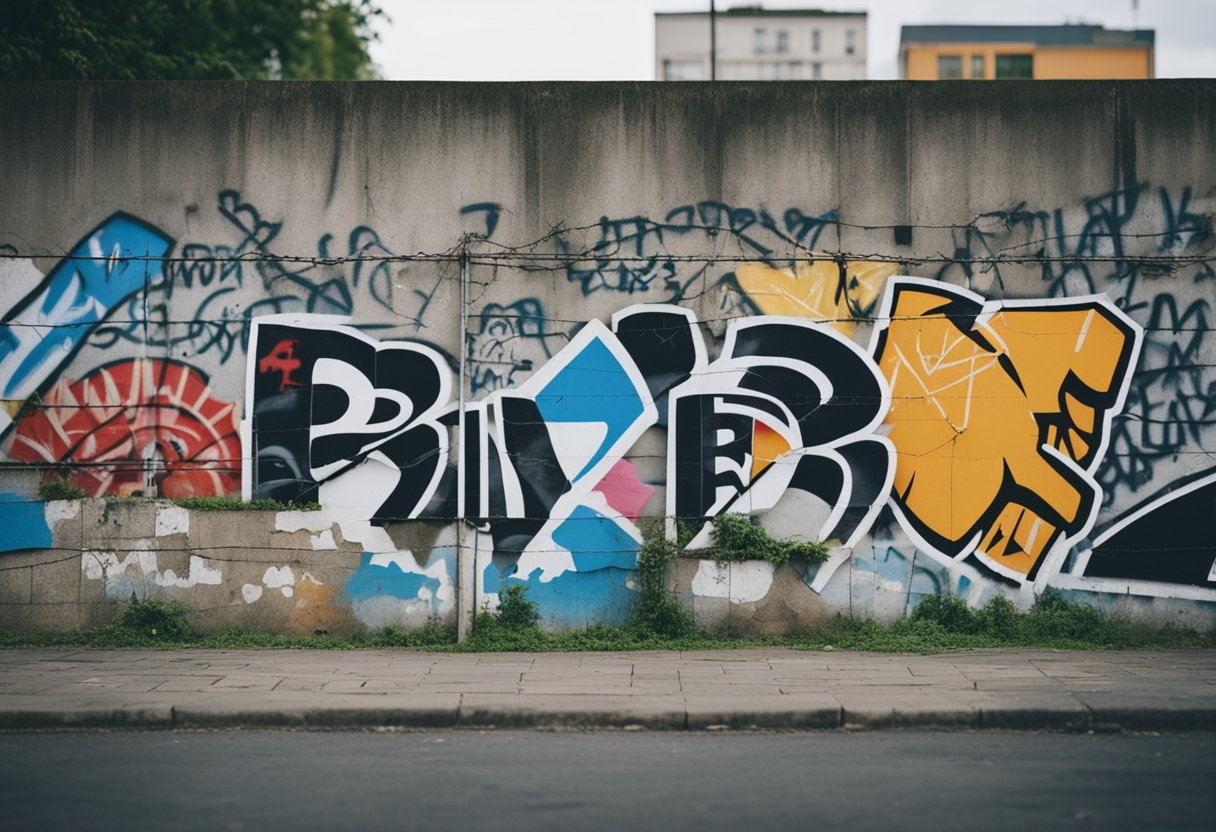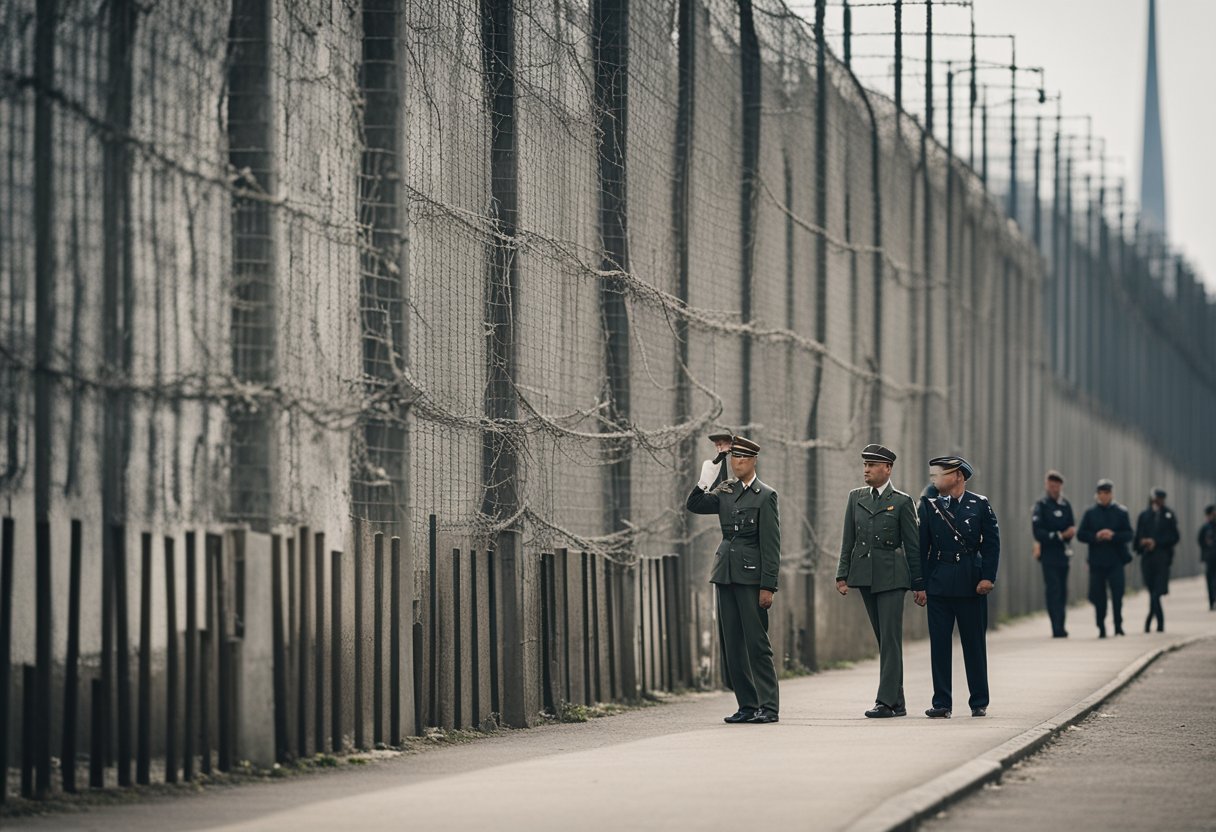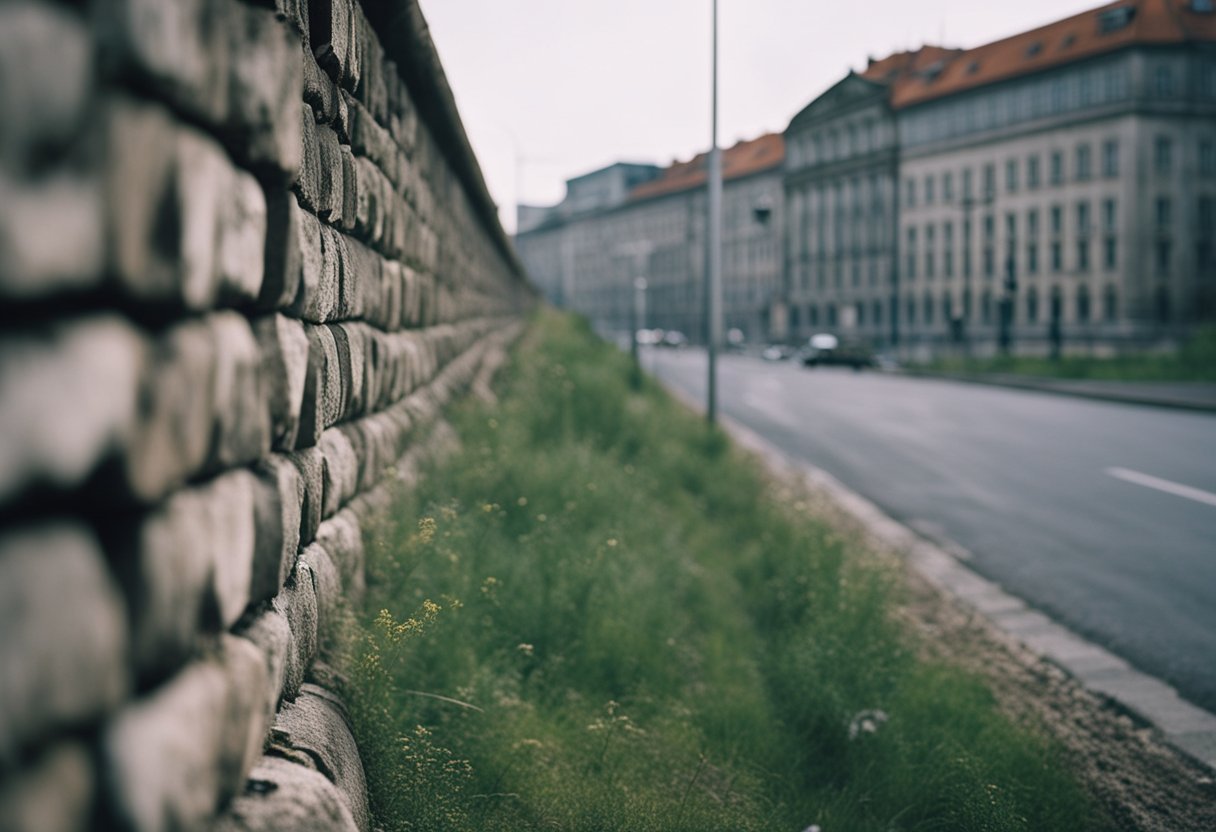The Berlin Wall was a formidable barrier that starkly divided East and West Berlin from 1961 until 1989. It stood not only as a physical demarcation but also as an iconic symbol of the Cold War, representing the divide between the communist East and the capitalist West.
On August 13, 1961, the communist government of the German Democratic Republic (GDR), or East Germany, took the drastic measure of erecting the Wall in an attempt to halt the flood of defections to West Berlin.
The Wall effectively encircled all of West Berlin, cutting through streets, neighborhoods, and even families, and stood as a stark reminder of the political and ideological rift between East and West Germany during the Cold War.
East Germany fortified the Berlin Wall with a fortified system and military presence to prevent escapes. In the History of Berlin Wall. early 1980s, East Germany had stationed thousands of border troops along the Berlin Wall, ready to enforce its perimeter.
These guards were infamously ordered to follow the “shoot-to-kill” policy or Schießbefehl against anyone attempting to escape to West Berlin.
For many, the Berlin Wall was not just a fence but a life-threatening obstacle to freedom and opportunity in the West.
The Berlin Wall stretched for over 140 kilometers and was more than a mere concrete structure; it was a complex of wire fencing, watchtowers, and anti-vehicle trenches.
Over time, it evolved into a sophisticated barrier known as the “death strip” that proved to be a fatal challenge for those daring to escape.
Various sections and images of the Berlin Wall bear witness to the graffiti-laden western side and the austere eastern side, encapsulating the tensions of a divided Berlin.
Its fall on November 9, 1989, marked not only the physical demolition of the barrier but also the figurative collapse of the Cold War division, leading to the eventual reunification of Germany.
Historical Context and Origins-History of Berlin Wall
The Berlin Wall, an enduring symbol of the Cold War, materialized from the geopolitical friction between the Allied powers and the Soviet Union and the division of Germany.
Its presence not only remodeled the landscape of Berlin but also epitomized the ideological clash of the era.
Post-War Germany and the Cold War
After World War II concluded, Germany was partitioned into four occupation zones, each controlled by one of the Allied powers: the United States, Britain, France, and the Soviet Union.
Berlin, deep within the Soviet occupation zone, was similarly split, underscoring the emerging Cold War tensions. This period was marked by escalating distrust and competition between the Western democracies and the Communist Eastern bloc.
Formation of East and West Germany
By 1949, two separate countries emerged: the Federal Republic of Germany (FRG), commonly called West Germany, and the German Democratic Republic (GDR), or East Germany.
West Germany was formed from the American, British, and French zones, while the Soviet zone became East Germany. This bifurcation cemented the Cold War divide in Europe and set the stage for a divided Berlin.
Construction of the Berlin Wall
In the early hours of August 13, 1961, the GDR began erecting the Berlin Wall, a physical barrier around West Berlin.
The wall was built to halt the exodus of East Germans dissatisfied with life under the Communist regime.
By the early 1980s, East Germany positioned approximately 11,000 border troops along the Wall, with orders to prevent escapes by any means necessary, including shoot-to-kill policies.
Berlin Airlift and Potsdam Conference
The Berlin Airlift and Potsdam Conference were pivotal events in the post-war era, shaping the future of Berlin and Germany.
The Conference, held in 1945 among the three major Allied powers—the United States, Britain, and the Soviet Union—set the terms for the post-war reconstruction of Germany.
Soon after, the blockade of Berlin by the Soviets in 1948 prompted the Western Allies to initiate the Berlin Airlift, supplying the city with vital necessities and marking the first major crisis of the Cold War.
Physical Structure of the Berlin Wall
The Berlin Wall stood as a complex barrier system, infamous for its comprehensive security measures designed to prevent escape from East to West Berlin.
Its structure evolved from makeshift fences to an intricate and fortified barrier that symbolized the division of the Cold War era.
Design and Modifications
Initially, the Berlin Wall began as a barbed-wire fence and was later replaced with a concrete wall to fortify the border.
Throughout its existence, the wall underwent modifications to enhance security, eventually forming a complex barrier system.
It featured multiple versions—the “Fourth Generation Wall,” constructed from 1975, was characterized by its grenade-shaped concrete slabs, making it harder to climb.
Death Strip and Watchtowers
The area between the main wall and the inner wall was known as the Death Strip: a heavily guarded no-man’s land filled with obstacles such as mines and electric fences.
Along the Death Strip stood numerous watchtowers, from which East German guards maintained a constant vigil. These guards had orders to prevent escapes by any means necessary, including the use of deadly force.
Border Fortifications
The border installations were an elaborate system, including border troops stationed along the wall. By the early 1980s, East Germany deployed thousands of guards for this purpose.
The fortifications also included a secondary wall, additional barbed-wire fences, and an array of anti-vehicle trenches—all part of the extensive security apparatus that earned the Berlin Wall the moniker “Wall of Shame” by its critics.
Life in Divided Berlin
In divided Berlin, the daily existence for Berliners was sharply demarcated by the Berlin Wall, impacting everything from personal relationships to the overarching political climate.
The Wall stood as a grim symbol of the Cold War, manifesting in concrete the ideological rift between East and West.
Daily Life and Separation Impact
After the construction of the Berlin Wall began on August 13, 1961, the lives of millions were abruptly and ruthlessly disrupted.
East Berlin and West Berlin became two starkly different realities. Families, friends, and communities were split; some residents found themselves cut off from their workplaces, schools, and homes.
Travel restrictions made crossing from East to West nearly impossible for most East Germans. For many, the division turned the once unified city into a landscape of loss and yearning.
Surveillance and Stasi
The Ministry for State Security, commonly known as the Stasi, maintained a pervasive surveillance system over the residents of East Berlin.
The agency recruited a vast network of informants, turning neighbor against neighbor. The Stasi was notorious for its ruthless methods to control and deter defectors.
East Germans lived under an umbrella of suspicion, knowing that any dissenting behavior could result in harsh punishment.
Escape Attempts
Throughout the Wall’s existence, over 5,000 successful escapes to West Berlin took place despite the numerous hazards. In the early 1980s, approximately 11,000 armed border troops guarded the fortifications.
Guards were under strict shoot-to-kill orders known as the “Order 101”, aimed at preventing any escape at all costs.
This threat did not deter all those desperate to flee; stories of escape attempts using tunnels, balloons, and forged documents became the stuff of legend, reflecting the profound human desire for freedom.
International Impact and Political Dynamics
The Berlin Wall was not just a physical barrier; it was a potent symbol of the ideological struggle between the East and the West during the Cold War.
This section explores the international tension, alliances, and espionage that were integral to this period.
Global Cold War Tensions
The construction of the Berlin Wall on August 13, 1961, greatly escalated the Cold War tensions.
It became the most recognizable symbol of the Iron Curtain, separating not just East and West Berlin but embodying the ideological divide between the United States and the Soviet Union.
Globally, it marked a clear frontier between the capitalist West, led by NATO forces, and the communist East, under the Warsaw Pact.
Allied Forces and the Soviet Bloc
The Allied Powers, consisting of the United States, Britain, and France, had sectors in Berlin which contrasted starkly with the Soviet Bloc, both in lifestyle and governance.
The Wall solidified this division physically, with its 155 kilometers length becoming an imposing boundary of influence.
Espionage and Political Games
Espionage played a critical role in the dynamics between the two blocs. Both sides deployed spies to gather intelligence and tried to outmaneuver each other on the political chessboard.
Notable incidents of espionage during this time included operations in Czechoslovakia and the exchange of captured agents at the Glienicke Bridge in Berlin.
The Soviet Union and East Germany maintained a vast network of informants through the Stasi, and in the early 1980s, the GDR had approximately 11,500 border troops posted along the Wall.
These forces were given orders to prevent escapes by any means necessary, leading to deadly confrontations at the border.
Dissolution and the Fall of the Berlin Wall
The fall of the Berlin Wall in November 1989 marked the culmination of the East German government‘s inability to keep its population isolated from the ideas of freedom and liberalization that were sweeping across other parts of Eastern Europe.
Gorbachev’s Policies and Reforms
Mikhail Gorbachev came to power in the Soviet Union in 1985 initiating a series of reforms under glasnost (openness) and perestroika (restructuring).
These policies aimed to increase transparency within the Soviet institutions and introduce political reforms to the communist system.
The ripple effect of these changes was felt profoundly in East Germany which thrived under rigid state control.
Public Protests and Government Response
By 1989, waves of mass demonstrations emerged in East Germany, as the local populace demanded political freedoms and democratization.
The East German government responded to these protests cautiously as it sought to maintain control while recognizing the pressures for reform.
An infamous phrase, “Niemand hat die Absicht, eine Mauer zu errichten” (“No one has the intention of building a wall”), which Walter Ulbricht declared two months before the construction of the Berlin Wall in 1961, became a poignant reminder of the state’s failing grip.
Opening of the Border and Fall of the Wall
On November 9, 1989, Günter Schabowski, an official of the East German government, mistakenly announced in a press conference that East German citizens could cross the border immediately.
Consequently, thousands of people flocked to the border crossings, such as Checkpoint Charlie, and overwhelmed the guards.
The East German border patrol, who had orders to shoot anyone attempting to escape but were not informed about the change, were unable to contain the crowds.
This led to the historical moment when the border was effectively opened, signaling the fall of the Berlin Wall and the subsequent process of German reunification.
In the early 1980s, East Germany had an estimated 12,000 border troops posted along the fortifications of the Berlin Wall.
They were under strict orders to prevent escapes to West Berlin, employing even lethal measures.
The Berlin Wall, erected in 1961, stood for 28 years as the most tangible symbol of the Cold War division between the capitalist west and the communist east.
Post-Wall Berlin and Reunification of Germany
The dismantlement of the Berlin Wall in 1989 ushered in a new era for Germany, leading to the official reunification of the Federal Republic of Germany (FRG) and the German Democratic Republic (GDR) on October 3, 1990.
This pivotal event brought significant challenges in terms of economic and social integration, the legalities of reunification, and the interlacing of cultural memories.
Economic and Social Integration
The coming down of the Berlin Wall symbolized the end of Communism in East Berlin and the beginning of the integration into a reunified and democratic Germany.
The economic miracle, or ‘Wirtschaftswunder,’ of West Germany starkly contrasted the economic stagnation of the GDR.
Efforts to level the economic landscape were paramount, including privatization of state-owned enterprises and the influx of capital into the former East Germany to rebuild its infrastructure.
Legal and Administrative Process
In the lead-up to reunification, Germany faced the monumental task of aligning two starkly different legal structures.
The Unification Treaty was designed to merge the two systems, with the FRG’s legal framework largely being adopted by the new federal states of the East.
This process included the disbanding of the GDR’s institutions and ensuring former Stasi operatives were removed from positions of power.
Cultural and Historical Memory
Preserving the history of the Berlin Wall and its impact has been vital in maintaining cultural and historical memory.
A conscious effort was made to integrate the narrative of both former German states, acknowledging the suffering and division caused by the Berliner Mauer.
Museums, memorials, and education programs serve to retain collective memories and guide democratic values.
In the early 1980s, the GDR stationed around 11,500 border guards along the Berlin Wall. If guards spotted anyone attempting to escape to West Berlin, they were under a “shoot-to-kill” order known as the “order to fire,” marking the severity of the situation at the time.
The construction of the Wall commenced on August 13, 1961, as a measure by the East German authorities to prevent their citizens from fleeing to the West.
Legacy and Modern Reflections
The Berlin Wall’s historical impact and its remnants continue to influence modern society, offering both a poignant reminder of the past and serving as a canvas for cultural expression.
Remnants of the Wall and Memorial Sites
Portions of the Berlin Wall still stand, particularly at the Bernauer Straße, where a memorial site has been maintained.
Here, visitors can view sections of the Wall complete with graffiti, as well as preserved cobblestones marking the Wall’s footprint.
Contiguous to this is the Documentation Centre, providing historical context through photographs and narratives.
Berlin Wall as a Cultural Icon
The Wall, once a symbol of division, has transformed into an emblem of freedom and creativity. Artists have used remaining fragments as backdrops for vibrant graffiti artworks.
Notably, the East Side Gallery, a long stretch of the Wall, showcases a series of murals that has become iconic, drawing tourists and serving as a canvas for political and social commentary.
Educational and Historical Tourism
Significant sites such as the Brandenburg Gate and Checkpoint Charlie have become integral stops for cultural and historical tourism in Berlin.
These locations, through photos and historical markers, narrate the story of the Berlin Wall.
Tourists often find pieces of the Berlin Wall for sale, sometimes chipped off with chisels by souvenir seekers, though such practices are now discouraged to preserve what remains of the historical structure.
Frequently Asked Questions
This section addresses common queries related to the construction, fall, and historical significance of the Berlin Wall, offering concise and factual answers.
Why was the Berlin Wall built?
The Berlin Wall was built to prevent the emigration of East Germans to West Berlin, which was proving a significant challenge to the East German government. Its construction began on August 13, 1961, aiming to stop the brain drain and stabilize the East German economy.
What led to the fall of the Berlin Wall?
The fall of the Berlin Wall was precipitated by the liberalization policies in Eastern Europe and pressure from massive public protests. On November 9, 1989, after a series of political changes, the East German government announced citizens could cross the border, leading to the Wall’s physical dismantling by jubilant crowds.
How did the Berlin Wall impact the Cold War?
The Berlin Wall symbolized the ideological division between East and West during the Cold War. It stood as a literal “Iron Curtain” and was a focal point for the conflict between capitalist and communist ideologies, making it a powerful symbol of the Cold War.
How long did the Berlin Wall stand?
The Berlin Wall stood for over 28 years, from its construction in 1961 until it was effectively breached in 1989. It was subsequently dismantled, with little remaining by 1992.
What are some significant facts about the Berlin Wall?
Key facts about the Berlin Wall include that at least 140 people died trying to cross it, and over 5,000 succeeded in escaping. In the early 1980s, East Germany had approximately 11,500 border guards posted along the Wall. The guards had orders to prevent escapes, which could include the use of lethal force.
How was Berlin divided in relation to the Berlin Wall?
Berlin was divided into East and West Berlin by the Berlin Wall. East Berlin, controlled by the German Democratic Republic (East Germany), was cut off from West Berlin, which was a political exclave of the Federal Republic of Germany (West Germany) and allied with the capitalist West. The Wall ran around all of West Berlin, isolating it from the surrounding East German territory.




